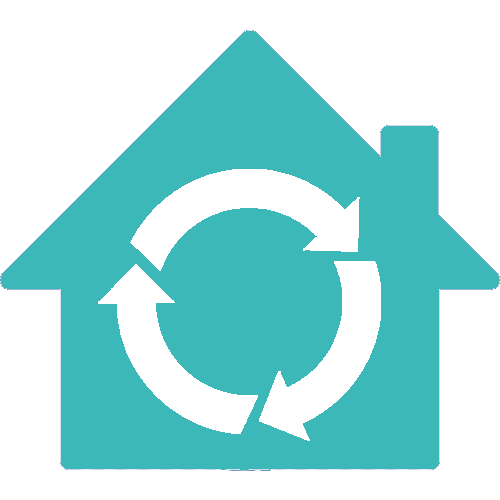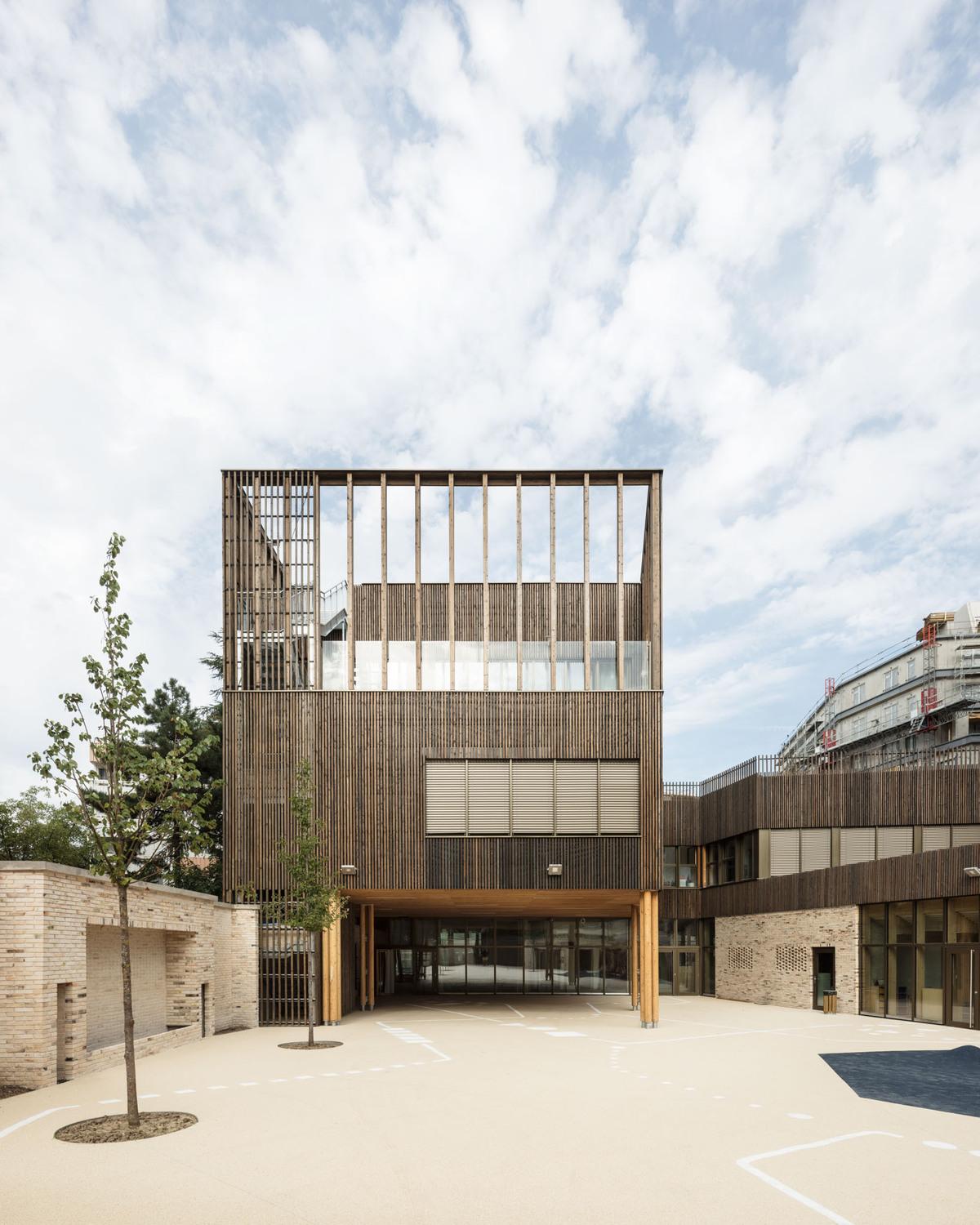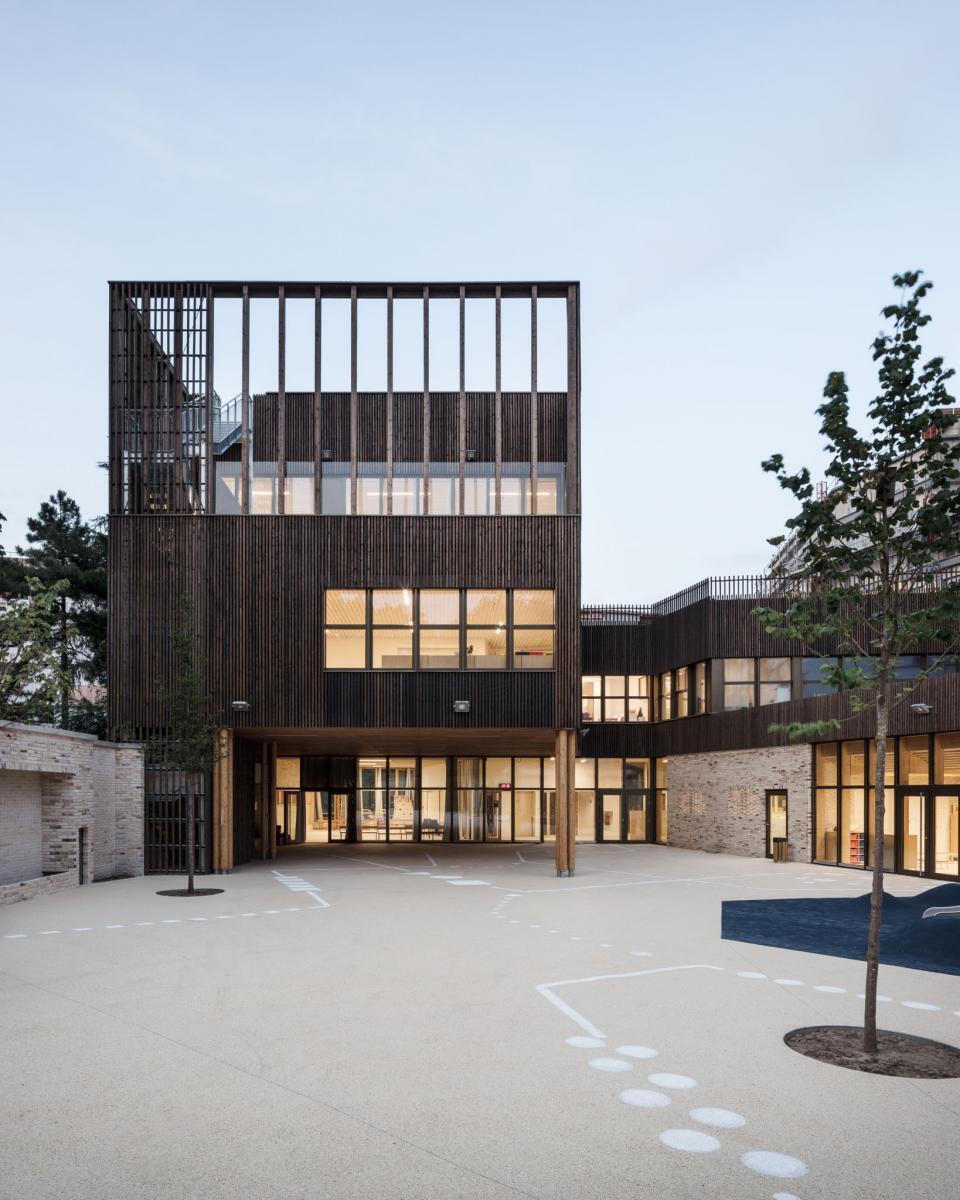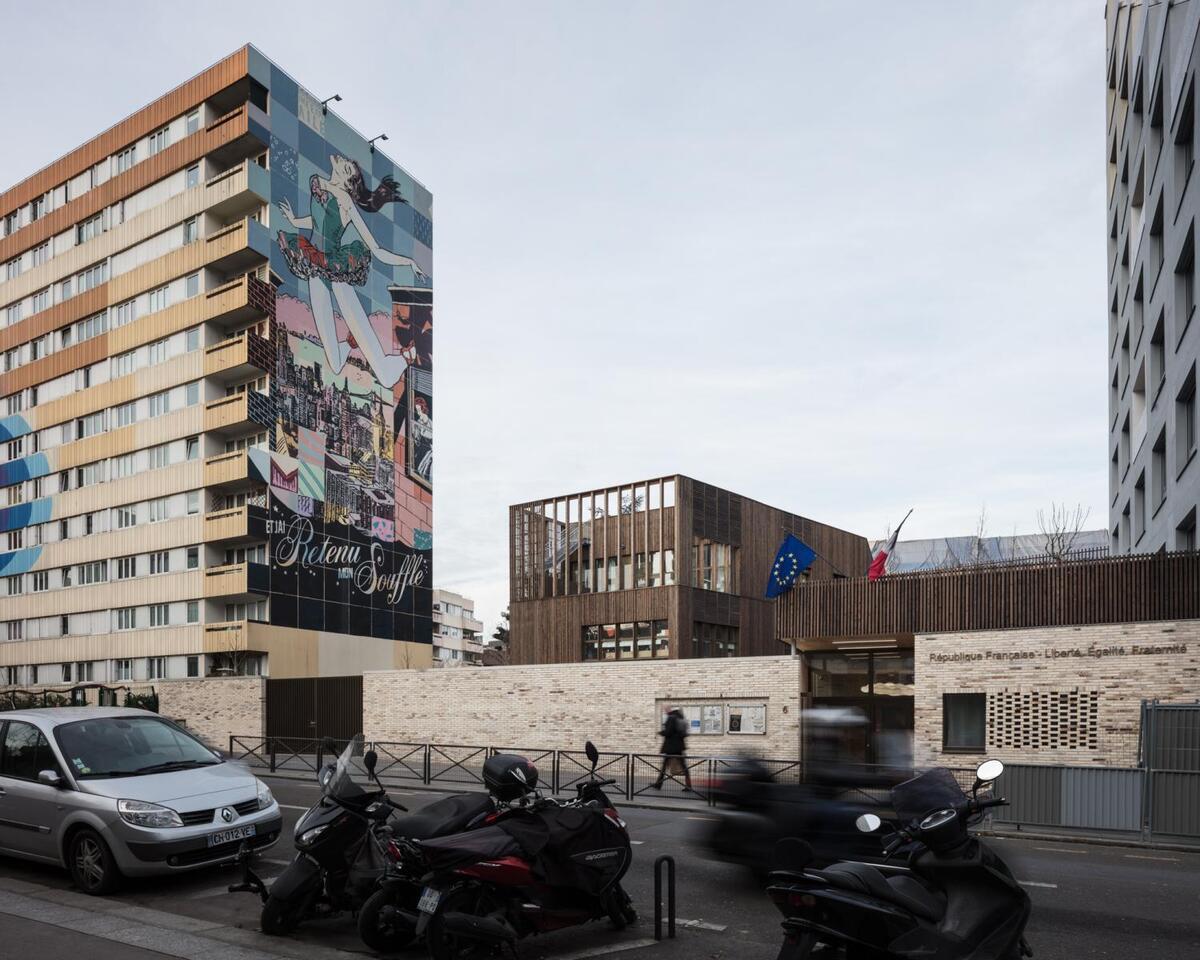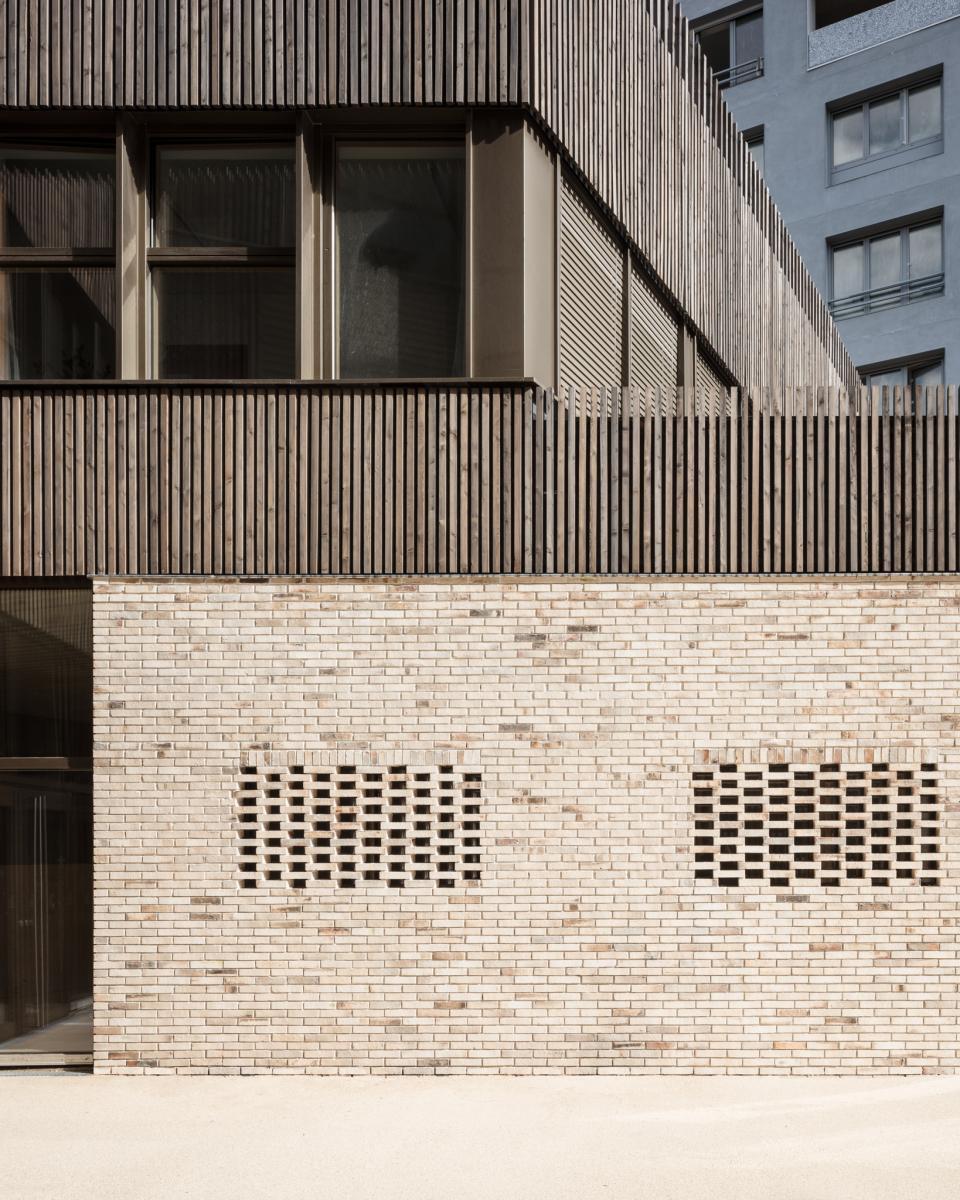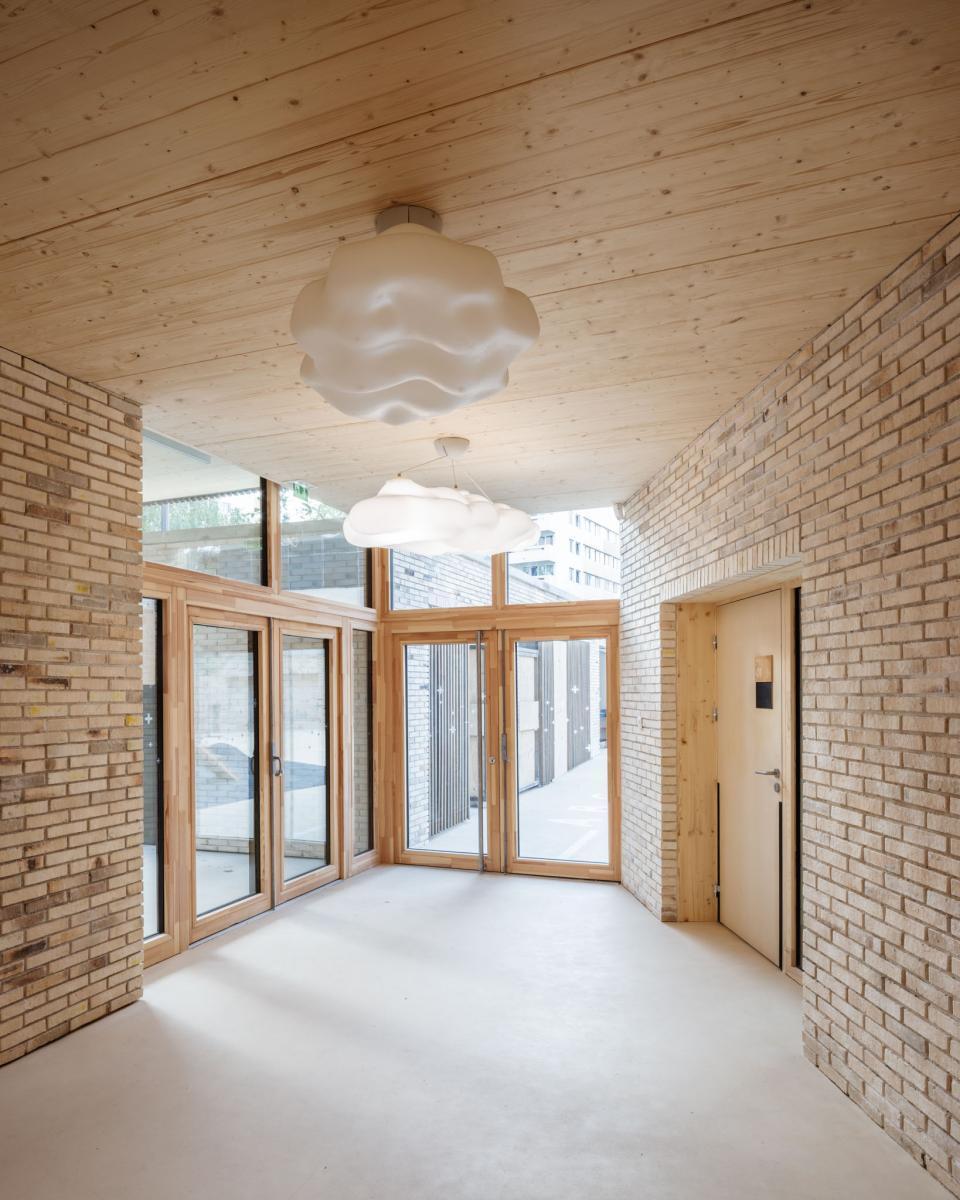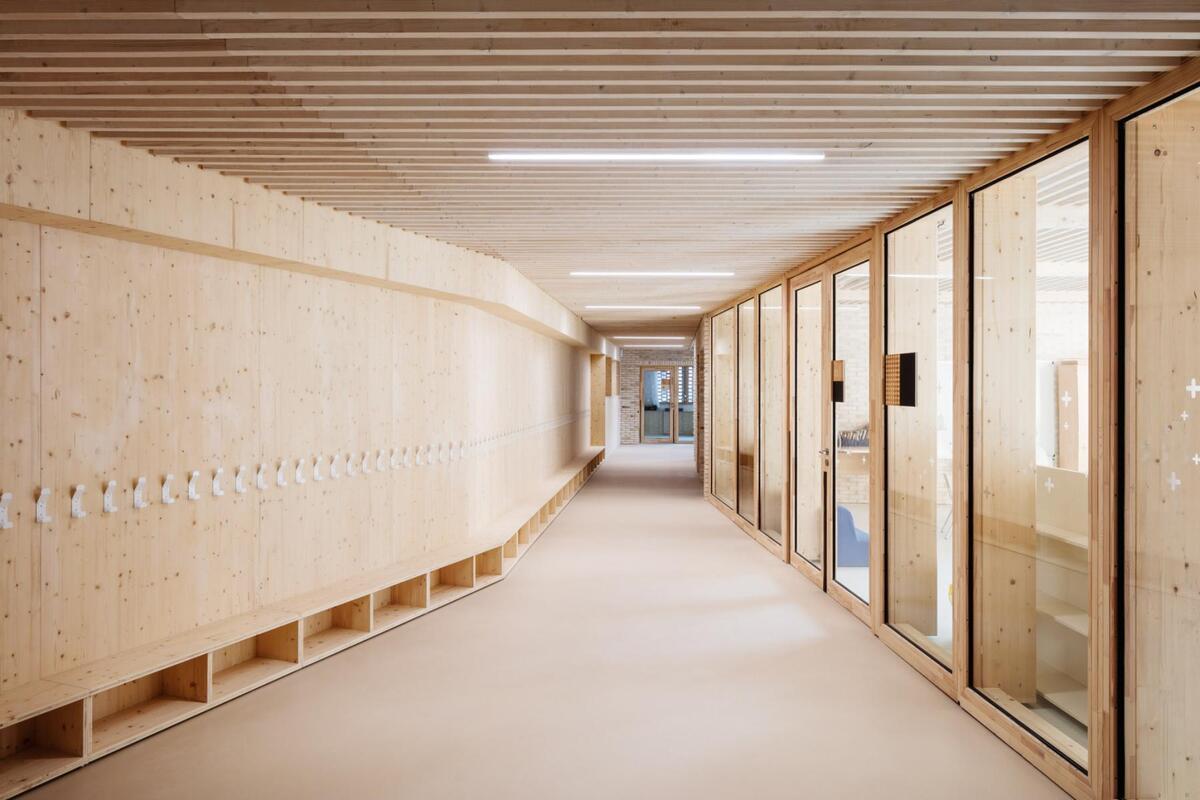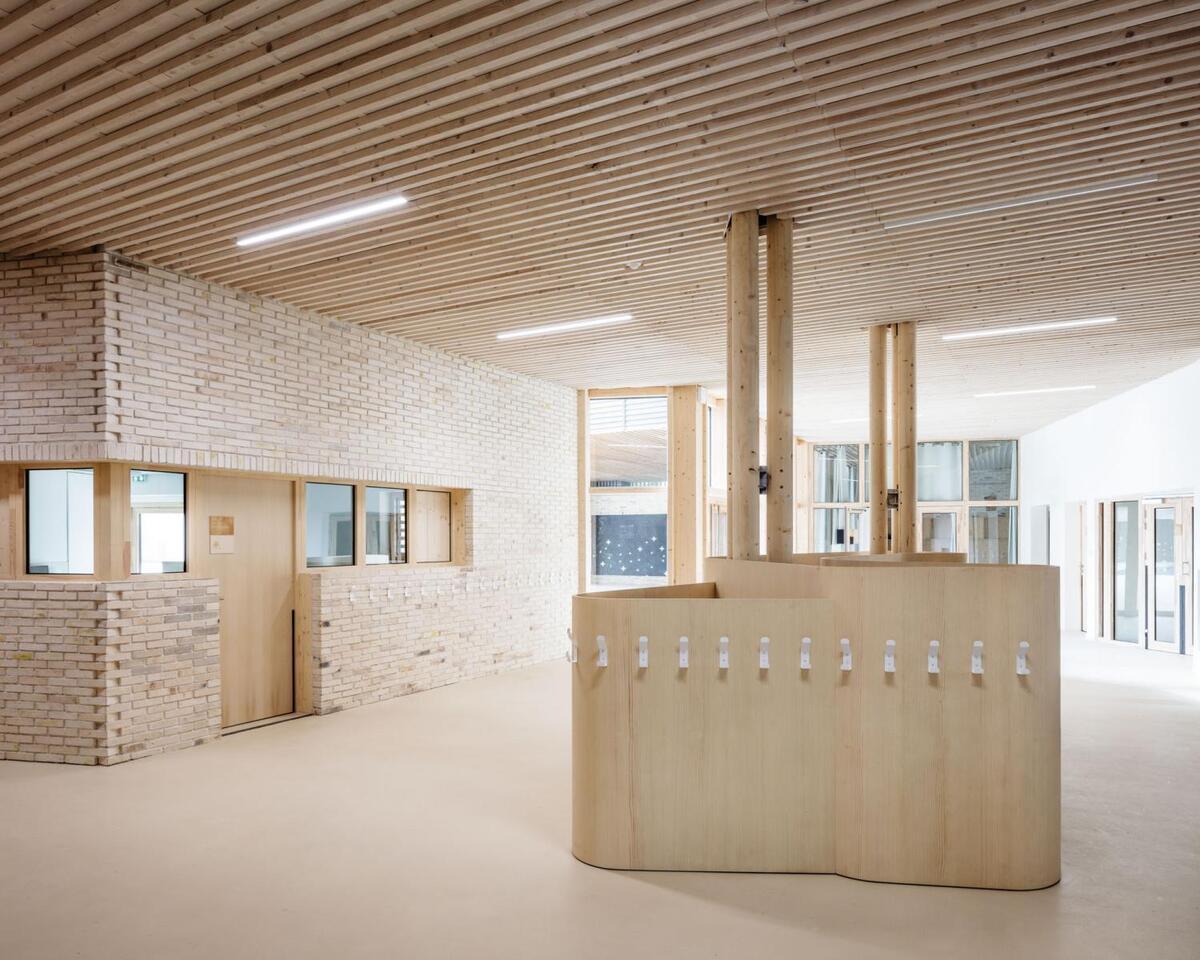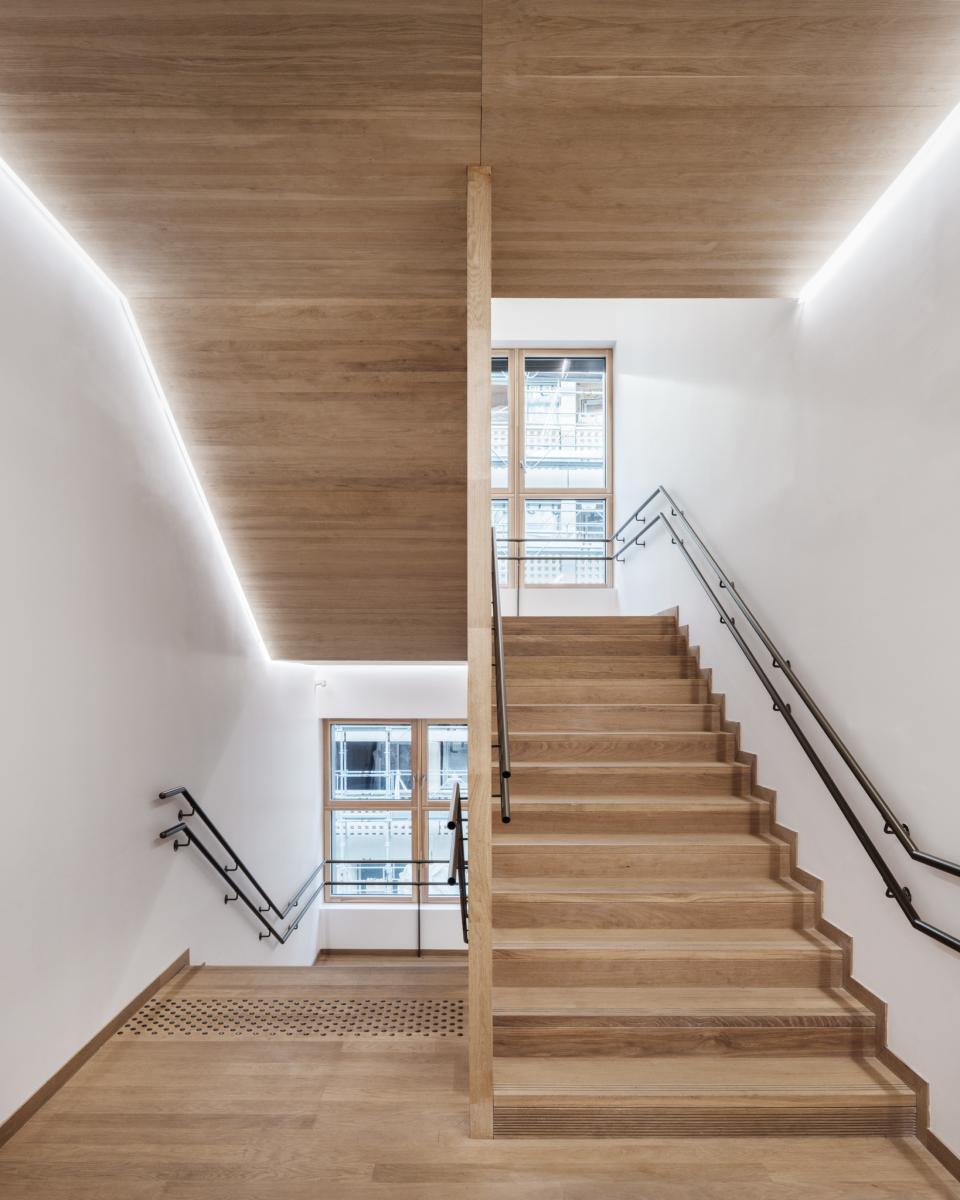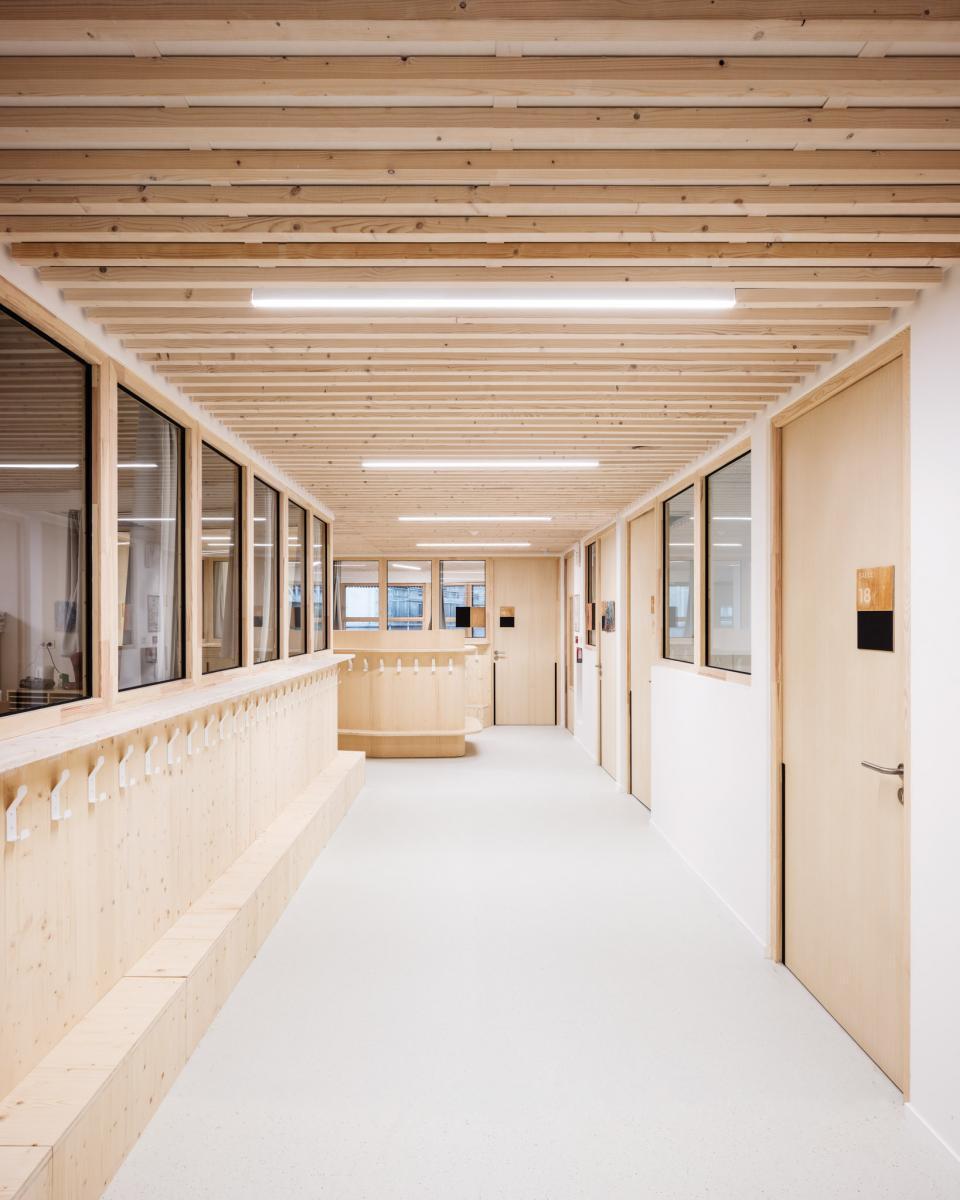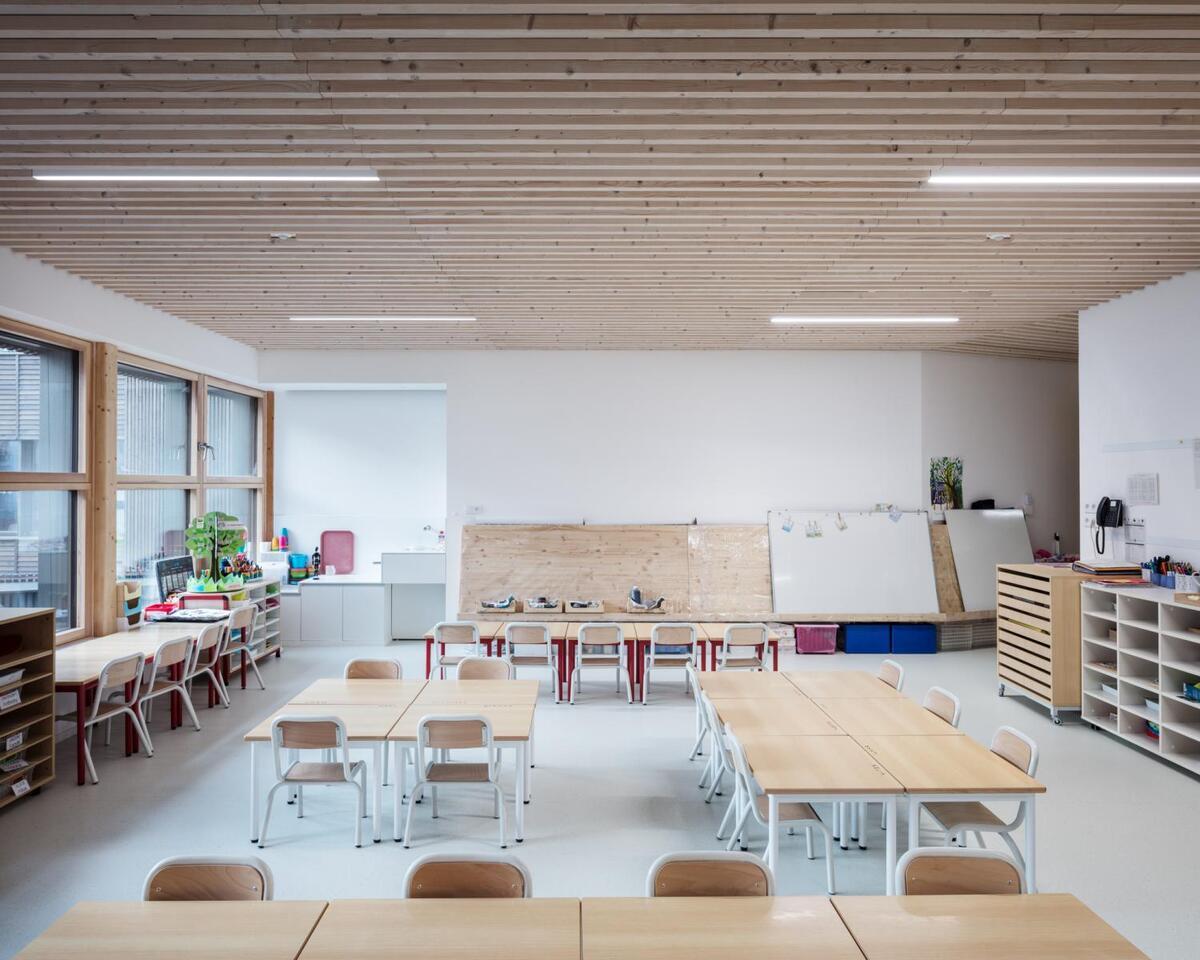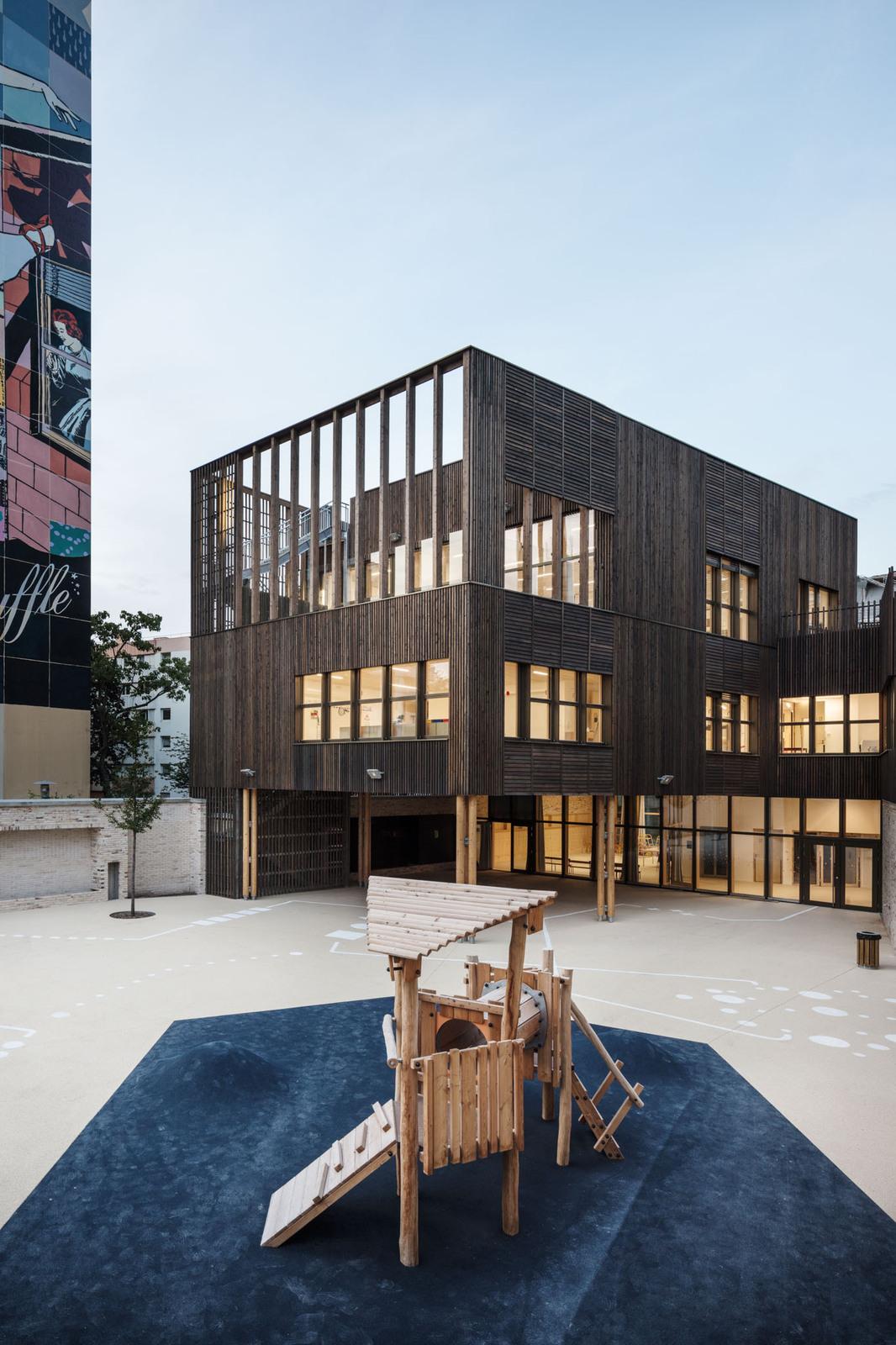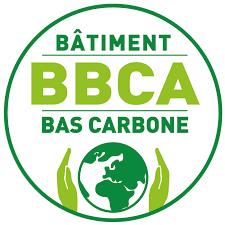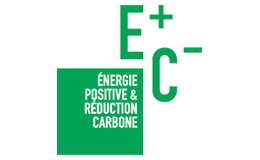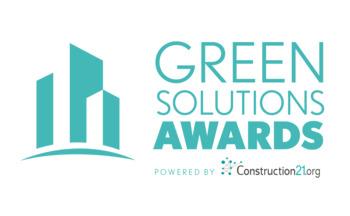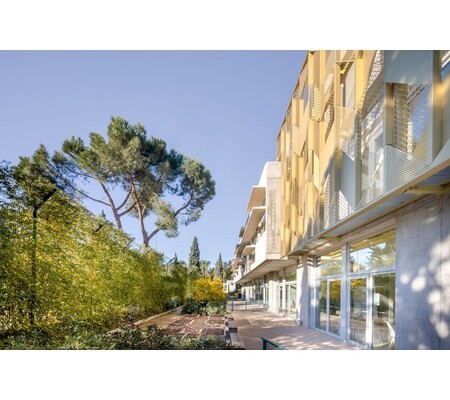Vincent Auriol nursery school in wood and straw
Last modified by the author on 15/03/2021 - 11:37
New Construction
- Building Type : Preschool, kindergarten, nursery
- Construction Year : 2019
- Delivery year : 2019
- Address 1 - street : 96, rue Jeanne d'Arc 75013 PARIS, France
- Climate zone : [Cfb] Marine Mild Winter, warm summer, no dry season.
- Net Floor Area : 1 753 m2
- Construction/refurbishment cost : 5 900 000 €
- Number of Children : 180 Children
- Cost/m2 : 3365.66 €/m2
Certifications :
-
Primary energy need
50 kWhep/m2.an
(Calculation method : RT 2012 )
In 2013, the Town Hall of the 13th arrondissement of Paris and SEMAPA launched a consultation process to develop block 82-90 of Boulevard Vincent Auriol. Specific objectives have been set for the Vincent Auriol nursery school: integrate biodiversity, have a low carbon footprint and good indoor air quality.
The project develops a polymorphic shape generated by the constrained geometry of the site, while providing as much green porosity and urban qualities as possible. Object of centrality, the school is then placed in the hollow of a landscaped ensemble, where each volume and facade interacts and is articulated with the urban space. Each level of the project, from the playground to the roof, is structured around an architectural promenade, an interior street that accompanies the program. Thus, each space is naturally lit and gives a view of this new landscape.
The project is conceived in a low carbon constructive approach . The choice of materials, both for the construction and for the facades and interior finishes, was made from a range of bio-based and geosourced materials. As the building is part of a passive design certification, heating needs are reduced by optimizing solar gain, a high-performance envelope and a double-flow ventilation system . The sense of the organic form of the project links up with environmental issues through the use and implementation of local and low-energy materials. The wooden walls are prefabricated in the workshop and the terracotta bricks are made near Paris, molded by hand and in one of the last traditional old ovens in France. In order to reduce the building's environmental footprint, a construction system in wood and straw was chosen. The primary energy consumption is also reduced by more than 60% compared to a standard building , which is considerable. The building's power supply comprises more than 50% of renewable energies. The constructive technical solutions implemented on this project respond to thermal performance and summer comfort issues, both interior and exterior acoustical constraints and a strong desire to reduce the building's carbon footprint. In this context, wood is developed in all its forms: wood frame wall envelopes and straw insulation, interior walls and floors in CLT, exterior wood-aluminum joinery, wood cladding (vertical cladding and horizontal cladding in tobacco dryer ) and wood finishings.
The project won the 2020 National Wood Construction Prize as well as the 2020 Séquence Bois Trophy, Biosourced category.
Sustainable development approach of the project owner
Begun in spring 2013, the operation to develop block 82-90 of Boulevard Vincent Auriol, led by SEMAPA, is taking its foundations in a consultation process initiated by the Town Hall of the 13th district and SEMAPA. This process continued with a vote of the inhabitants for the choice of the urban scenario. Three development proposals produced by the coordinating architect Urban Act were presented to them. The choice was made concrete by a block sheet serving as a common thread for the housing and school design workshops, in which representatives of the neighborhood councils were able to take part.
The objectives set for the candidates within the framework of this consultation testify to the environmental requirement carried by the SEMAPA:
- Biodiversity, by maximizing the vegetated surfaces, particularly on the roof or even on the facade, which will be treated in a very qualitative way and by choices of devices and reasoned species, intended to register the project in an exemplary way in the continuity between the different neighboring green spaces;
- The quality of the indoor air, taking into account the proximity of the boulevard and the skytrain and taking into account the nature of the program, so as to ensure a very high level of health for children and supervisory staff;
- A low carbon footprint of the project, by favoring the use of biobased materials and paying particular attention to gray energies in construction and manufacturing, by controlling and anticipating the entire process from design to operation , using the building's life cycle analysis (LCA). This assumed, supported and financed requirement has made it possible to carry out an innovative project, implementing constructive processes which contribute to the quality of interior life and which respond to environmental issues.
Architectural description
The architectural approach and its materiality have developed around the questioning of the depth of the course, of the interior street. How do you cross a slender, mono-oriented building for nearly 40 meters? How to occupy this space-time? With what program? What light and what relation to the outside? This is where the idea of an interior street was born, which expands to announce a direction, a leisure center, and accompanies children and parents to the heart of the school. This street is materialized by a punctuation of interior constructions, thick functional and structural volumes. These thick brick walls delimit the spaces dedicated to children. Finally, the partitions between circulation and children's premises are made of a wooden frame, often load-bearing, completely glazed. The street is then lit on both sides by direct shots on the facade or through these glazed rooms, themselves in relation to the courtyard.
The entrance hall opens generously to the interior street. It links the leisure center, the cleanliness area, the restaurant and the motor skills room, and also participates in the route created with the interior street: it is a walk that leads to the classes. The servants' spaces are designed with the same quality as the served spaces, naturally lit and with fittings integrated into the construction. The functionality of the project is based on this principle: each constructive, partitioning or functional element has a different use: creating a framework, announcing a particular space, directing, tidying up, etc. The interior street serves the various functional and educational spaces all along the route. Always with the concern that at any point, the gaze can be placed on the outside: when the interior street expands towards the facades or in the second day through the large rooms dedicated to children.
See more details about this project
https://www.la-architectures.com/projets/ecole-vincent-auriolPhoto credit
Charly Broyez
Contractor
Construction Manager
Stakeholders
Construction Manager
Atelier Desmichelle
0661169590
https://www.atelierdesmichellearchitecture.fr/Co-contractor architect
Thermal consultancy agency
AI Environnement
0149741210
http://ai-environnement.fr/
Gaujard Technologie scop
0490861696
http://www.bet-gaujard.com/Wood structure and envelope in bio-based materials
Mecobat
0141195610
https://mecobat.com/Concrete structure and VRD
Structures calculist
CdB Acoustique
0172840750
http://www.cdbacoustique.fr/Other consultancy agency
Ecallard Economiste
0142221715
http://www.ecallard-economiste.com/Construction economics
Construction Manager
Atelier Volga
0953124725
http://ateliervolga.com/Landscaper
Other consultancy agency
QCS Services
0173951109
https://www.qcsservices.fr/Fire Safety System Coordination (SSI)
Energy consumption
- 50,00 kWhep/m2.an
Envelope performance
Systems
- Urban network
- Electric floor heating
- Urban network
- No cooling system
- Nocturnal Over ventilation
- Double flow heat exchanger
- No renewable energy systems
Urban environment
- 4 356,00 m2
- 28,00 %
Construction and exploitation costs
- 5 900 000 €
GHG emissions
- 3,00 KgCO2/m2/an
Reasons for participating in the competition(s)
Le projet engage une démarche bas carbonée globale, notamment grace à une analyse de cycle de vie du bâtiment (ACV). Dans ce but, les énergies grises lors de la construction et de la fabrication du projet ont été prises en compte. Ainsi, l'opération atteint le niveau E3C1 du label E+C-, ainsi que la certification HQE option label "Bâtiment Biosourcé" (2ème niveau), le label Effinergie et respecte le Plan Climat Ville de Paris. Il s'agit également du premier bâtiment public labellisé BBCA niveau Excellent.
Le choix de matériaux biosourcés et du bois a été un facteur déterminant pour que le bâtiment soit bas carbone, grâce à l’exploitation du phénomène de puits de carbone. Un système constructif en bois et en paille a été mis en place avec l’objectif de stocker le CO2. En complément de l'isolation en paille, d'autres solutions bas carbonées ont été mises en place comme le choix d'isolants incompressibles en verre recyclé pour les toitures végétalisées et la dalle du sous-sol. La ventilation double flux, en sus de l'excellente performance thermique de l'enveloppe, a permis de réduire les besoins en chauffage à <15 kWh/m²/an.
Le projet paysager de l'école répond à l'objectif de continuité écologique. Les différentes terrasses qui s’étagent se dessinent comme une succession de jardins. Ecrin et filtre pour protéger l’école, cadre privilégié pour les enfants et jardins d’agrément pour les logements mitoyen, cette nature apportera un bien être et favorisera la biodiversité. Les revêtements de sol de la cour sont poreux, permettant une infiltration naturelle et limitant ainsi l'imperméabilisation des sols urbains.
Building candidate in the category
